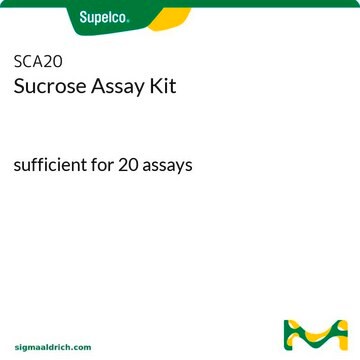MAK263
Glucose Colorimetric/Fluorometric Assay Kit
sufficient for 100 colorimetric or fluorometric tests
Sign Into View Organizational & Contract Pricing
All Photos(1)
About This Item
UNSPSC Code:
12161503
NACRES:
NA.84
Recommended Products
usage
sufficient for 100 colorimetric or fluorometric tests
application(s)
cosmetics
food and beverages
detection method
colorimetric
fluorometric
relevant disease(s)
endocrinological disorders, diabetes
storage temp.
−20°C
General description
Glucose is a primary energy source that naturally occurs in its free state in fruits and other plant parts. Abnormal glucose levels have been associated with several metabolic dysfunctions such as hypoglycemia, hyperglycemia, and diabetes mellitus. Measurements of glucose levels in tissues and body fluids (such as blood and urine) are often used for the diagnosis of glucose– related disorders. Glucose levels are also monitored to check the efficacy of therapeutics such as insulin and sulphonylureas in type 2 diabetics.
Features and Benefits
Compatible with high-throughput handling systems.
Suitability
Suitable for the determination of glucose concentrations in various biological samples, including serum, plasma, food, or growth medium. This kit is also suitable for monitoring glucose levels during fermentation and glucose feeding in protein expression processes.
Principle
Glucose is oxidized to generate a colorimetric (570 nm)/ fluorometric (λex = 535/λem = 587 nm) product, proportional to the amount of glucose present. The kit is able to detect 1-10,000 μM of glucose in various samples.
related product
replaced by
Product No.
Description
Pricing
Signal Word
Danger
Hazard Statements
Precautionary Statements
Hazard Classifications
Aquatic Chronic 3 - Resp. Sens. 1
Storage Class Code
10 - Combustible liquids
Flash Point(F)
Not applicable
Flash Point(C)
Not applicable
Choose from one of the most recent versions:
Certificates of Analysis (COA)
Lot/Batch Number
Don't see the Right Version?
If you require a particular version, you can look up a specific certificate by the Lot or Batch number.
Already Own This Product?
Find documentation for the products that you have recently purchased in the Document Library.
Ryan K Perkins et al.
Nutrients, 11(3) (2019-03-03)
The purpose of this investigation was to evaluate the effects of experimental hyperglycemia on oxidative damage (OX), advanced glycation end products (AGEs), and the receptor for AGEs (RAGE) through an in vivo approach. Obese subjects (n = 10; 31.2 ±
Mike Boger et al.
Frontiers in cell and developmental biology, 10, 918529-918529 (2022-07-26)
The ELMO protein family consists of the homologues ELMO1, ELMO2 and ELMO3. Several studies have shown that the individual ELMO proteins are involved in a variety of cellular and developmental processes. However, it has poorly been understood whether the Elmo
Gemma K Kinsella et al.
International journal of molecular sciences, 22(19) (2021-10-14)
GPR21 is a constitutively active, orphan, G-protein-coupled receptor, with in vivo studies suggesting its involvement in the modulation of insulin sensitivity. However, its precise contribution is not fully understood. As the liver is both a major target of insulin signalling
Ye Du et al.
Frontiers in oncology, 10, 580176-580176 (2021-01-05)
Hypoxia is an important environmental factor and has been correlated with tumor progression, treatment resistance and poor prognosis in many solid tumors, including triple-negative breast cancer (TNBC). Emerging evidence suggests that long noncoding RNA (lncRNA) functions as a critical regulator
Abigail M Maucieri et al.
Biology of reproduction, 104(4), 914-923 (2021-02-08)
Glucose is a preferred energy substrate for metabolism by bovine granulosa cells (GCs). O-linked N-acetylglucosaminylation (O-GlcNAcylation), is a product of glucose metabolism that occurs as the hexosamine biosynthesis pathway (HBP) shunts O-GlcNAc sugars to serine and threonine residues of proteins.
Our team of scientists has experience in all areas of research including Life Science, Material Science, Chemical Synthesis, Chromatography, Analytical and many others.
Contact Technical Service






